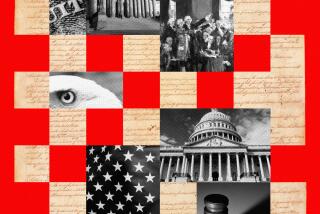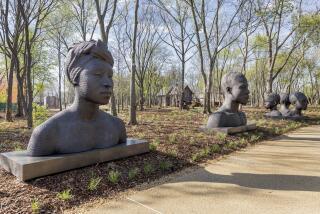Museum’s Goal: A More Perfect Union
- Share via
PHILADELPHIA — In this city where patriots such as George Washington, James Madison and Alexander Hamilton gathered 216 years ago to write the U.S. Constitution, a museum opens today paying tribute to the document.
The purpose of the National Constitution Center, its leaders say, is to bring the history of the nation’s charter to life and to persuade visitors that democracy is a participatory process.
For the record:
12:00 a.m. July 5, 2003 For The Record
Los Angeles Times Saturday July 05, 2003 Home Edition Main News Part A Page 2 National Desk 1 inches; 53 words Type of Material: Correction
Philadelphia museum -- An article in Friday’s Section A on the opening of the National Constitution Center said that visitors could enter a model of the floor of the Senate during the impeachment trial of President Andrew Jackson. It was President Andrew Johnson who was impeached in 1868, not Jackson. Johnson was acquitted.
“We hope it will be a national center in which all citizens of America can come to understand more about their rights and responsibilities under the Constitution,” said Richard R. Beeman, vice chairman of an advisory panel of scholars.
Added Joseph M. Torsella, the center’s president and chief executive: “We have museums in America about the peanut, the gourd, NASCAR racing and Barbra Streisand, but not about the Constitution, which is not a problem unless you care about the future of self-government in America.”
Outside Torsella’s office, workers were putting the finishing touches this week on the $185-million granite, limestone and glass building on Philadelphia’s Independence Mall. Museum officials say they hope it will draw as many as 1 million visitors a year.
During today’s ceremony, Mayor John F. Street will present Philadelphia’s Liberty medal to Supreme Court Justice Sandra Day O’Connor. Two other Supreme Court justices, Stephen G. Breyer and Antonin Scalia, serve with O’Connor on the center’s distinguished scholars panel.
The center -- nonprofit and nonpartisan -- was established by the Constitution Heritage Act of 1988, which was passed by Congress and signed by President Reagan. It is supported by a combination of federal, local and private funds.
Polls taken by the museum show the challenge it faces in bringing the Constitution to life: More teenagers can name the Three Stooges than the three branches of the federal government, one survey found.
“It is very easy for us to visualize a romantic story about war and independence, but the Constitution doesn’t get the same kind of play,” said Torsella, a deputy mayor for policy and planning under former Philadelphia Mayor Edward G. Rendell.
“People see it as an abstract. People see it as a lawyers’ document,” he added. “People view it as something the Supreme Court keeps locked up in a vault and pulls out in October and puts away in June.”
One of the museum’s strategies is to surround and embrace visitors with the Constitution, whose complete text is etched on huge glass panels in a circular gallery the size of two full city blocks.
The gallery contains a series of interactive high-tech civics lessons.
One exhibit replicates the U.S. Supreme Court bench. Visitors can become immersed in three cases, listening to the oral arguments. They can also watch themselves being sworn in as president or walk into a 1940-style living room and hear one of President Franklin D. Roosevelt’s fireside chats on a radio.
Traveling farther back in history, visitors can enter a model of the floor of the Senate during the impeachment trial of President Andrew Jackson and listen to the debate.
An “American National Tree” tells the stories of 100 people whose actions influenced the Constitution.
The central theme that democracy demands participation is introduced from the moment people walk in the front door. Instead of being handed traditional tickets, they are given a delegate’s pass to the Constitutional Convention.
Orientation takes place in a star-shaped theater during a 17-minute show that begins with an actor dressed in modern clothing asking a central question: “What makes us Americans?” These words begin a multimedia production that ends with the question, “What will we do with freedom?”
Signer’s Hall, the museum’s last exhibit, contains life-size statues of 42 framers of the Constitution.
Finally, visitors are asked whether they would sign today’s Constitution and are given the opportunity to affix their names next to the document’s authors on replicas. Dissenters -- there were three at the original Constitutional Convention -- can state their reasons.
“From beginning to end,” Torsella said, “the exhibit is about trying to pull you in, trying to make you see the story is about you.”
More to Read
The biggest entertainment stories
Get our big stories about Hollywood, film, television, music, arts, culture and more right in your inbox as soon as they publish.
You may occasionally receive promotional content from the Los Angeles Times.










